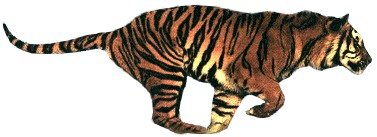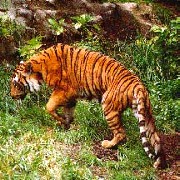  About Tigers: Information from WWF Canada
The tiger (Panthera tigris) is the largest of all cats, and one of the most fearsome predators in the world. A typical male Siberian tiger may weigh 230 kilograms (500 pounds), and measure more than three metres from its nose to the tip of its tail. Tigers roam over large distances, and can leap up to 9 metres in one jump.  The tiger's orange colouring and black stripes provide good camouflage in its environment. Both white and black tigers have also been known to occur in the wild; most white tigers have been bred for this characteristic, while black tigers are actually ones where the stripes merge together. The tiger's orange colouring and black stripes provide good camouflage in its environment. Both white and black tigers have also been known to occur in the wild; most white tigers have been bred for this characteristic, while black tigers are actually ones where the stripes merge together.
Tigers are at the top of the food chain: they eat just about anything, and nothing eats them. They have been known to eat crocodiles, fish, birds, reptiles, and even other predators like wolves, leopards and bears. However, to remain healthy they must include hoofed animals such as deer in their diet. The biggest prey animals, such as water buffalo, provide so much food that the tiger won't hunt again for a week. More than 36 kilograms (80 pounds) of meat may be eaten at one sitting. Hunting is often difficult, however, and tigers are only successful in one or two attacks out of every twenty.  Tigers are usually solitary, and come together only to mate. Gestation lasts about three and a half months. Two or three cubs are normally born, inside a den made from thick vegetation, a cave, or a rocky crevice. Mother tigers nurse for three to six months, although the kittens may begin eating meat as early as two months old, and can hunt by the time they're one year of age. Cubs l stay with their mother for about 2 years. About half of all cubs survive to their third year. Male tigers roam a large territory, the size of which depends on the terrain. In Russia, territories may be as large as 1000 square kilometres, while a male tiger in India may occupy 100 square kilometres or less. Tigers mark their territories with urine, feces, and scratching on tree trunks. Tigers are Endangered:  Tigers are threatened by habitat loss, as towns, cities, and land cleared for farming all are increasing in size. But a more important reason for their declining population is that they are killed for their parts, which are used in traditional Chinese medicine. China, Taiwan, Hong Kong, South Korea, and Japan all trade in tiger parts. This trade can bring in huge profits for poachers and illegal traders. The parts of a single tiger can be sold for a sum of Tigers are threatened by habitat loss, as towns, cities, and land cleared for farming all are increasing in size. But a more important reason for their declining population is that they are killed for their parts, which are used in traditional Chinese medicine. China, Taiwan, Hong Kong, South Korea, and Japan all trade in tiger parts. This trade can bring in huge profits for poachers and illegal traders. The parts of a single tiger can be sold for a sum of North American and Western European countries also are contribing to the killing of tigers; according to one recent investigation, 41% of traditional medicine shops surveyed in the U.S. sold medicines labeled as containing tiger or rhino parts. The last hundred years have seen major losses of wild tigers. By the 1950s, tigers living around the Caspian Sea were extinct. Populations of tigers that once inhabited the islands of Bali and Java are now extinct. The last Bali tiger was killed in 1937; the last Javan tiger sighting occured in 1972. India today has the largest number of tigers, with between 3,000 and 4,800. The South China tiger, with at best 20 to 30 individuals, is nearly extinct in the wild.  It is estimated that only 5,100 to 7,500 individual tigers now remain in the entire world. This includes tigers in zoos. It is estimated that only 5,100 to 7,500 individual tigers now remain in the entire world. This includes tigers in zoos.The remaining wild tigers are threatened by many factors, including growing human populations, loss of habitat, illegal hunting of the tiger and the species they hunt, and a growing trade in tiger parts for traditional medicines. The World Wildlife Fund and many other organizations are now working to combat these threats, to try to save the tiger. You can help by visiting their website and making a monetary contribution. |